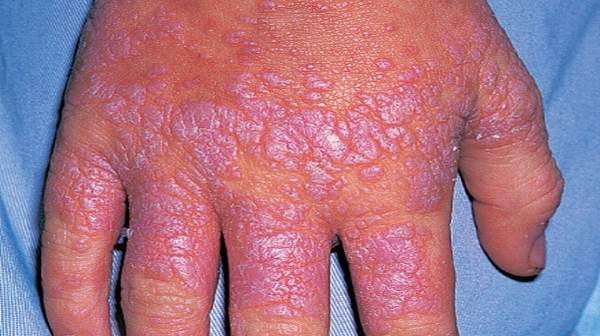What's in this article?
Lichen planus is an “eruption of flat-topped, shiny, violaceous papules on flexor surfaces, male genitalia, and buccal mucosa of unknown cause; may form linear groups; microscopically characterized by a bandlike subepidermal lymphocytic infiltrate. Spontaneous resolution is common after months to years.”
The word lichen refers to the lichen plant which grows on rocks or trees, while the word planus in Latin means “flat”.
Lichen planus is an inflammatory skin condition, characterized by an itchy, non-infectious rash of small, polygonal (many sided) flat-topped pink or purple lesions (bumps) on the arms and legs. Other parts of the body may also be affected, including the mouth, nails, scalp, vulva, vagina, and penis. Involvement in the scalp can result in hair loss – sometimes permanent.
According to the National Institutes of Health (NIH), USA, lichen planus affects between 1% and 2% of the American population. According to the National Health Service (NHS), UK, around 1 in every 50 people is affected by lichen planus.
Nobody knows what the exact causes of lichen planus are. We know it can be triggered by taking certain medications, including thiazide diuretics, antimalarials and phenothiazines (a group of tranquilizing drugs with antipsychotic actions). A significant number of skin specialist doctors (dermatologists) believe it might be classified as an autoimmune disease. A higher-than-normal percentage of people with hepatitis C and some other liver diseases have lichen planus.
Oral lichen planus is more common in women than in men. Skin lichen planus affects both sexes equally. It typically occurs in people over 30 years of age. About half of all affected people have oral lichen planus (symptoms in the inner surface of the mouth). Oral lichen planus typically occurs inside the cheeks, but may also affect the lips, gums and tongue.
Lichen planus Facts
- Does not appear to be an hereditary condition – you cannot pass it on to your children
- Is not an infectious condition – you cannot catch it from somebody with the condition
- Is not a form of cancer
- Occurrence does not seem to be linked to nutrition. However, spicy foods, citrus juices, and tomato products may aggravate symptoms if there are open sores in the mouth.
Symptoms of Lichen Planus
Some of the most common symptoms of lichen planus include the following:
- purplish-colored lesions, or bumps, with flat tops (mostly found on the wrist, inner forearm, or ankles, but can be anywhere)
- lesions that develop and spread over the course of two weeks to a few months
- itching at the site of the rash
- lesions in the mouth, which may be painful or cause a burning sensation
- blisters, which become scabby after bursting
- thin white lines over the rash
The most common type of lichen planus affects the skin. The lesions appear and spread over the course of several weeks and usually clear up within six months to a year and a half. Less commonly the lesions can occur on mucous membranes, genitalia, nails, and the scalp. There are also variations of the condition that are more common in the Middle East, Asia, Africa, and Latin America.
How is Lichen Planus Diagnosed?
Usually, lichen planus is relatively straightforward to diagnose. Physicians can make the diagnosis in typical cases simply by looking at the rash. If necessary, a skin biopsy may be done to help confirm the diagnosis because, under the microscope, lichen planus is distinctive in appearance.
Because there are a number of other lichenoid eruptions that resemble lichen planus a biopsy confirmation is frequently necessary. Persistent oral or vaginal lichen planus, with spots that thicken and grow together, can sometimes be difficult to distinguish clinically from whitish precancerous plaques called leukoplakia. A biopsy can be helpful in this situation. There seem to be a few patients in whom ulcerative lichen planus precedes the development of oral cancer.
Treating Lichen Planus
For mild cases of lichen planus, which usually clear up in weeks or months, you may not need any treatment. If the symptoms are uncomfortable or severe, your doctor can prescribe certain medications that may help. There is no cure for the condition, but medications that treat the symptoms are helpful and some may even be able to target a possible underlying cause. Possible medications include one or more of the following:
- retinoids: Retinoids are medications that are related to vitamin A. They can be used topically or taken orally to treat your rash.
- corticosteroids: These help to reduce the inflammation of a lichen planus rash, and can be topical, oral, or given as an injection.
- antihistamines: These also reduce inflammation and may be particularly helpful if your rash is triggered by an allergen.
- nonsteroidal creams: There are topical creams available that can suppress your immune system and help clear up the rash.
- light therapy: In some cases, treating lichen planus with ultraviolet light seems to help.
Lichen planus is rarely severe and, although it can be uncomfortable, is not a dangerous condition to have. With treatment and time, your rash will clear up and you will once again have normal skin.








Excellent post. I'm experiencing many of these issues as well..
My blog post – libertine